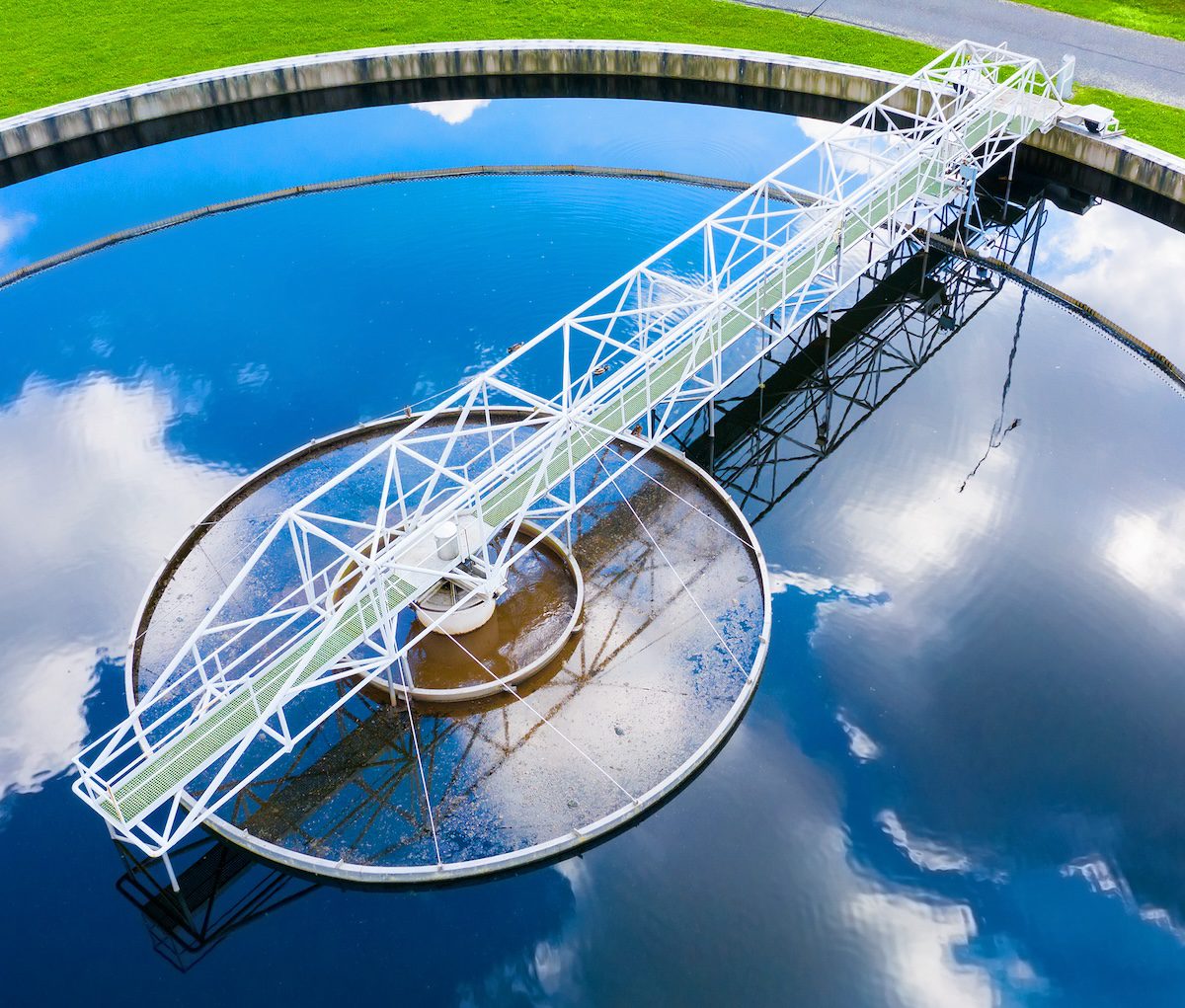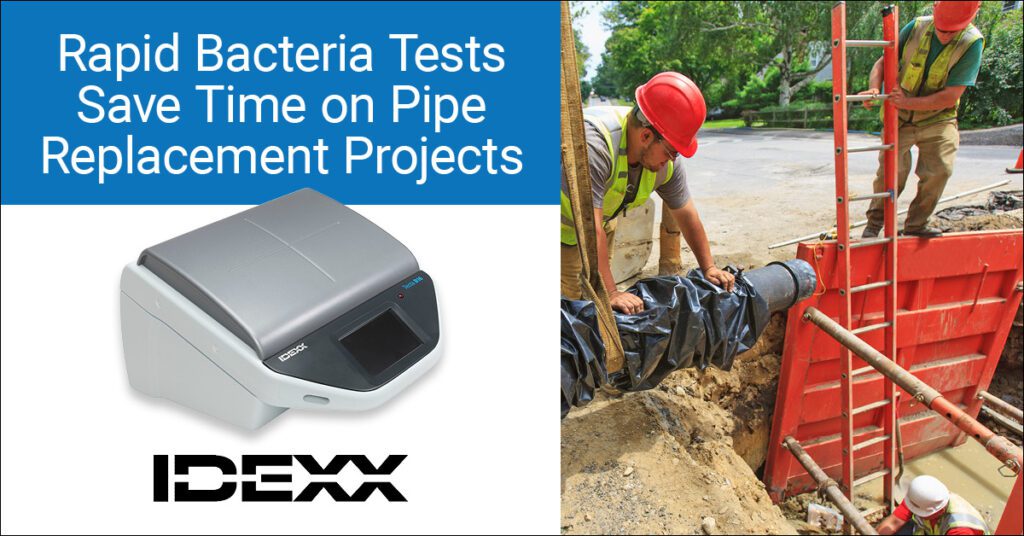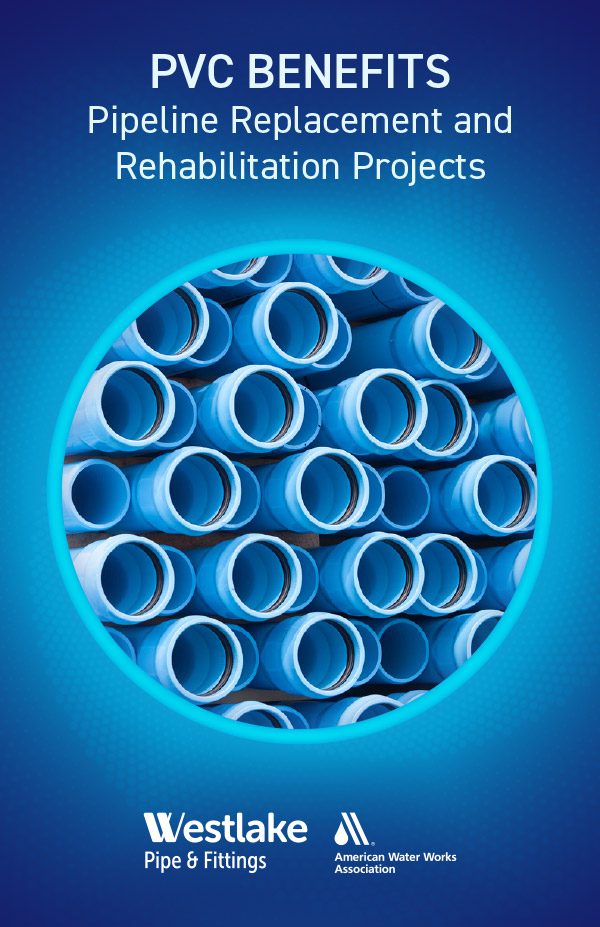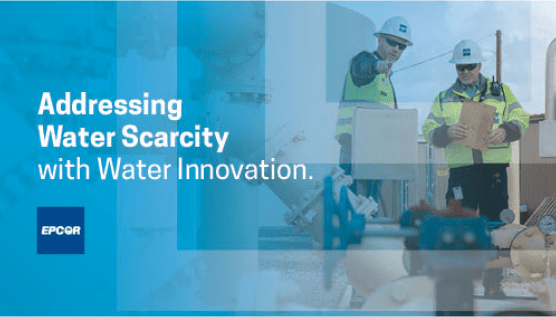Industry Insights
AWWA industry partners offer a wealth of knowledge, insights and solutions on crucial water-sector issues and opportunities.


We are honored to showcase the expertise of our partners through special content developed in partnership with AWWA. We value their commitment to the water sector and appreciate their support of AWWA.

IDEXX: Rapid Bacteria Tests Save Time on Pipe Replacement Projects
The City of Minneapolis Water Treatment and Distribution Services (WTDS) adopted an automated approach to testing water systems used to deliver household water during pipe replacement projects.
The IDEXX Tecta system delivers the same analytical quality as traditional enzymatic test methods for water microbiology—but in real time, tightening project timelines and reducing staffing costs.
Before being able to start tests anytime with IDEXX Tecta, “For a 24-hour sample taken at 2 p.m. on Tuesday, we wouldn’t be able to act on a passed sample until Thursday without working overtime,” explained WTDS General Foreman. “With that same sample in the Tecta, we can act on Wednesday during our regular shift. That saves tens of thousands of dollars.”
Learn How They Did It

PVC Benefits Pipeline Replacement and Rehabilitation Projects
Lightweight, durable, corrosion-resistant PVC pipe is a popular choice when utilities are replacing or rehabilitating water infrastructure. This concise, practical e-book (prepared by AWWA in partnership with Westlake Pipe & Fittings) covers the key properties, uses, and advantages of PVC water pipe.
Also included is guidance on:
- Pipe specification and project design
- Trenchless installation options (to minimize surface disruption)
- Best practices for working with PVC water pipes
The guide also examines how one utility replaced its entire distribution system with PVC pipe using trenchless construction methods.
Learn More
Understanding the Value of PVC Water Pipes
PVC pipe has long been a popular choice when utilities are replacing or rehabilitating water mains or expanding water systems. Still, it’s important not to take for granted anything about this essential aspect of water infrastructure.
AWWA’s new Essential Knowledge Series e-book, PVC Benefits Pipeline Replacement and Rehabilitation Projects (developed in partnership with Westlake Pipe & Fittings) offers a concise, practical overview of the key properties, uses, and advantages of PVC water pipe.
Recently, AWWA’s Amy Gahran sat down with two experts from Westlake Pipe & Fittings — Keith Moggach, manager of specification engineering, and Craig Fisher, regional engineer — to discuss some key topics that can help water utilities ensure that they realize the full value of their investment in PVC water pipe.
How can PVC pipe support sustainability and environmental goals?
Moggach: When you think about what “sustainable” means, a key consideration is that it’s important to install pipe that will last a very, very long time. PVC water pipe can last 100 years or more. Because they’re made of inert materials, they are far less prone to corrosion, which can lead to breaks or water contamination.
Product quality matters. If you want PVC pipe that really lasts, make sure you know what you’re buying. Look for products with readily available published information: life cycle assessments and environmental product declarations that conform with internationally recognized standards. Check which products reduce toxicity and greenhouse gas emissions in the manufacturing process. These evaluations should be third-party certified and peer-reviewed by experts.
Fisher: If I worked for a utility, I’d want a product that is easy to maintain. Researchers at Utah State University published some excellent research on water main break rates. They found that PVC pipe had the lowest overall break rate, which reduces the overall cost of ownership. As part of this research, they dug up old PVC water pipes, tested them, and they tested out like new products.
What are some things utilities can do to ensure that their PVC pipe lasts as long as possible?
Moggach: Achieving the full design life starts with writing good design specifications and following best practices when installing PVC pipe. When problems do occur, the most common root cause is improper installation practices—especially improper bedding and over-insertion of the joint.
When installing PVC pipe, there should be a layer of soil underneath the length of the pipe. Wherever a pipe rests on large rocks or a bedrock outcrop, that creates a point load. PVC pipe is not designed to handle that stress in a pressurized water application.
Fisher: Proper training of utility staff is really important to avoid installation issues. A foreman who moved up the ladder at a utility might have a lot of experience with PVC pipe installation, but knowledge may not have been passed down to the newer workers. This guide can support training new staff. It covers all the basics, and it’s easy to refer back to as needed.
Also, manufacturers have a lot of great tips for installing PVC pipe. It’s a good idea to reach out to them to confirm the latest best practices before installation begins.
What are some of the main advantages of trenchless installation of water mains?
Moggach: The biggest benefit is that there’s less disruption of the surface area. You’re not shutting off access to roads or sidewalks to dig the entire length of the installation. That tends to minimize inconvenience to people who live or work in, or are passing through, the area of the installation project. It can also help control the time and cost of the project. Plus, you don’t have to pay to truck away and replace lots of dirt, asphalt, and concrete.
Fisher: The pipe-bursting method of replacing existing pipe makes use of the existing right-of-way. That can save considerable time and effort for project permitting, with far less risk of accidental damage to adjacent gas, electric, or telecom lines.
Directional drilling can help avoid obstacles that are not possible to dig through, like a river or large trees. Communities want to protect their environmental features, and pipe installation practices can support this goal.

Phoenix faces big water challenges, EPCOR delivers innovative solutions
The Phoenix, Ariz., metro area faces water challenges that demand an innovative response. EPCOR has deployed a diverse portfolio of solutions to deliver reliable, ample water supply as the region and population continue to grow.
EPCOR’s solutions so far include:
- Reclaiming more than 90% of wastewater and putting it to other uses
- Using innovation to increase the efficiency of its operations, like wastewater treatment plants
- Ensuring future water access through agricultural partnerships
- Responsible water conveyance for municipal and major industry projects
- Innovative storage, through an award-winning wastewater aquifer recharge basin topped by a public park
Learn How They Did It

Xylem: Data-Driven Pipeline Management
It’s not always obvious when buried infrastructure is deteriorating — until it fails. Pipeline management presents some of the most difficult choices for any water utility. An asset management program, driven by condition data (not assumptions), is a proven way to reduce risk, control costs, and extend the useful life of critical pipelines and valves.
This guide (prepared by AWWA in partnership with Pure Technologies, a Xylem brand) explains how utilities are making the leap to data-driven pipeline management — starting with risk analysis, collecting and analyzing assessment data, and developing a plan to deliver maximum benefits from a limited budget.
Start improving the long-term health of your pipelines today.
Learn More
Pipeline Condition Data
AWWA’s new Essential Knowledge e-book, Empowering Data-Driven Pipeline Management (developed in partnership with Pure Technologies), offers an in-depth exploration of how water utilities are leveraging data to extend the life of transmission mains and wastewater force mains.
Recently, Eric Toffin, P.E., Global Product Manager for Metallic Pipeline Solutions at Xylem, sat down with AWWA to discuss how utilities are embracing digital technologies to become more efficient and effective about addressing aging infrastructure.
How do utilities benefit from getting more proactive about how they assess, control, and manage pipelines?
Toffin: Developing a complete, accurate, and current dataset about pipelines helps utilities control costs, increase operational efficiency, reduce truck rolls, and minimize impacts to their reputation.
Digging up pipelines — especially large, critical pipelines — is complex, challenging, and costly work. That’s true for planned digs, but it’s even more true when a utility needs to fix a break that’s already interrupted service and possibly caused adjacent damage. Digs are disruptive to customers and the public, including pedestrian and vehicle traffic.
That makes it crucial to dig in the right location the first time, with the right resources on hand, and to complete the work quickly and smoothly. Good data about the current condition of underground pipelines supports all of these best outcomes.
In our experience, 4% of pipes show signs of damage, and even fewer require repair or replacement. You can save a lot by targeting those bad pipes. When you find and address specific pipes with damage, you can restore the useful life of your entire pipeline to near new.
Why is pipeline condition data a strategic utility asset?
Toffin: Most utilities know the criticality and failure history of their pipelines, but they know less about the actual condition of their underground infrastructure. Corrosion, surge events, and other factors can take an invisible toll on buried water and wastewater pipes. Not all leaks create detectable signs at the surface.
When age and historical failures are the main factors determining when a pipeline gets repaired or replaced, utilities run a big risk of tearing out pipes that still have a lot of useful life left.
Manufacturing methods and materials have changed a lot over the decades. A cast iron pipe installed in the early 20th century might have a useful life of 100 years or more, because the pipe walls were very thick. The useful life of a ductile iron pipe installed in the 1960s might be half that; the industry transitioned to thinner walls after iron was in short supply during World War II.
Unfortunately, this means that many utilities are facing a pending tsunami of pipelines reaching the end of their design life. They can’t just play whack-a-mole by addressing failures as they happen, and they can’t replace everything. They need a strategy for how and when they update aging infrastructure. Getting good pipeline data is an essential step in that strategy.
How can pipeline condition data help utilities avoid surprises?
Toffin: Good data helps utilities make sure their pipeline and valve records match the reality in the field.
Knowing where to dig isn’t always easy. Often, the precise locations of underground pipelines do not completely match plans or GIS data. Where are those pipes, bends, and valves, exactly? A pipe that originally was off to the side of a small road 80 years ago might be under the middle of a bigger, busier thoroughfare today.
Valves are another important concern. Typically, utilities know where valves are located — but are those valves functioning? When a valve is inoperable, it’s common to replace it, rather than repair it.
The Essential Knowledge Series guide tells how the City of Grand Rapids saved money by repairing, rather than replacing, its large valves. Nearly every utility in the world faces this choice, and hundreds of thousands — if not millions — of dollars are at stake.
How does condition data enhance the economics of operating a pipeline network?
Toffin: Good pipeline data supports better budgeting. Utilities not only realize more value from every dollar spent on repairing and replacing pipelines — they also can more accurately estimate how much they’ll need to spend, and when.
Planned repairs are always easier and less expensive than after-hours emergency calls. There’s less pressure and time crunch to get the work done.
Of course, more efficient use of resources yields savings. When underground infrastructure unexpectedly fails, a utility may not have the right equipment and materials to fix the problem in their yard. Good pipeline data means fewer emergencies and better preparation.
Pipeline condition data informs financial planning, too. Analyzing trends lets you plan work in the coming years. You can build targeted projects into future capital plans, get funding approved easily, schedule shutdowns, and coordinate with stakeholders and communities.
Why might condition assessment be helpful even if your pipes aren’t that old?
Toffin: It’s helpful to develop a good baseline understanding of pipeline condition. Even in relatively young pipelines, we’ve seen hotspots of activity — for example, places with hot soils, where the pipe lining or coating is damaged, and corrosion is increasing.
A pipeline condition assessment program identifies red flags early, so you can keep a close eye on them over time. Once managers know where these hotspots are, that helps steer future inspection and maintenance work.
Starting a condition assessment program may seem daunting, but it becomes easier once you start. The experience your team gains with this process reduces the time and effort needed for the regular reinspection cycle. Plus, inspection and monitoring tools are getting better all the time, and it keeps getting easier to get them into, out of, and through buried pipelines.
It’s never too late to start building valuable institutional knowledge. The savings and value only grows over time.
AWWA does not assume responsibility for opinions or statements of facts expressed by contributors, and editorials do not necessarily represent official policies of the association. Mention of any product(s) and/or service(s) shall in no event constitute an endorsement of the entity that manufactures, distributes, or promotes the products or services.



